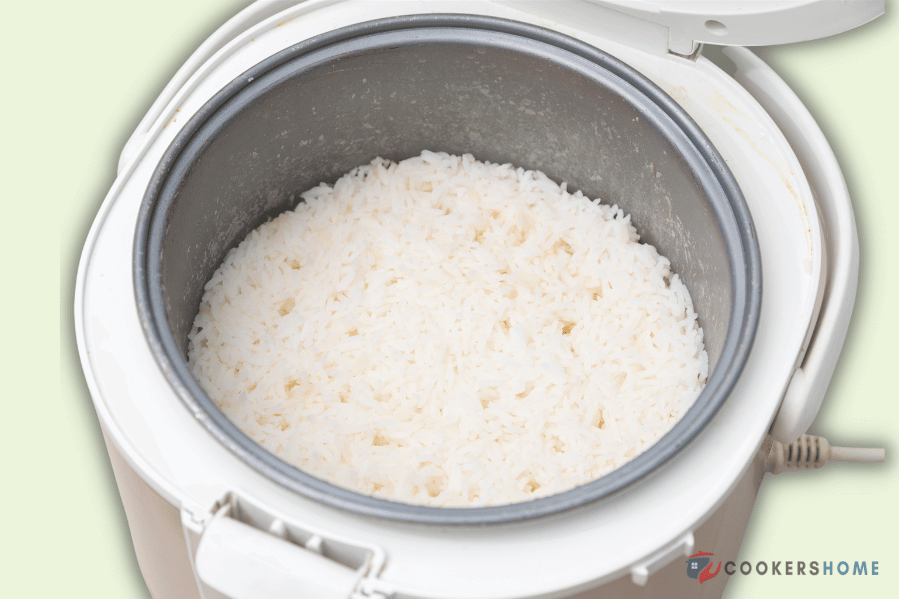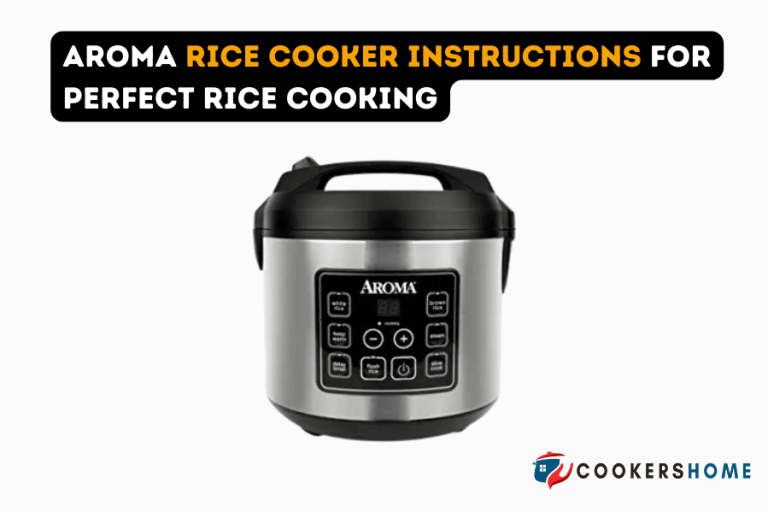How Do You Avoid Rice Sticking to the Rice Cooker?

Cooking rice is an essential kitchen skill. But cooking rice in such a manner that they are not sticky or mushy and has that perfect grain that can be used for fried rice and other side dishes is a skill in itself. Do you want to get an expert in this skill? Then you are in the right place!
When rice sticks, they become clumpy and look messy, which could affect the overall presentation of your meal. Although sticky rice doesn’t affect the rice’s taste, its texture influences the overall sense of flavor. Sticky rice feels heavy and starchy in the mouth. So today, we are here to find solutions to avoid rice sticking to the rice cooker.
This article will explore why rice sticks to the rice cooker, different methods to avoid rice sticking, and last, we will answer the question: how can you remove burnt or stuck rice from the cooker? So, let’s begin!
Table of Contents
Why does Rice Stick to the Bottom of the Rice Cooker?
Rice sticking to the bottom of the rice cooker is a common frustration that many home cooks face. So first, it’s essential to understand the reasons behind this phenomenon. In this way, you can prevent it in the future. Here are a few factors that contribute to rice sticking to the rice cooker’s inner pot.
The first and most common reason for sticky rice is that you don’t wash the rice before cooking. When you don’t rinse rice before cooking, that starch makes the grains stick together. Another reason could be Insufficient water. Water evaporates during the cooking process. And if there isn’t enough to keep the rice moist, it can result in dry and sticky rice.
Another culprit for rice sticking could be worn out or scratched nonstick coating of your rice cooker. Nonstick pots help prevent sticking, but the rice can stick to the bottom when the coating is damaged. Now that you know why rice sticks to the cooking pot, let’s find their effective solutions to make your meal appealing and delicious again.
13 Different Ways to Avoid Rice Sticking to the Rice Cooker

There are various methods to prevent rice from sticking to the rice cooker. Here are 13 practical and proven ways which you can try.
1. Grease the Inner Pot
The first solution to avoid rice sticking to the bottom of the inner pot is to grease it. Coat the sides and bottom of the rice cooker with cooking oil or butter. It helps lubricate the rice grains and prevent them from sticking together. You can also add oil during the cooking process. When you add oil during cooking, it allows it to get absorbed into the grains. As a result, it will also improve the taste of the rice and prevent them from sticking.
Cooking Hack: To enhance the flavor and texture of your rice, and prevent them from clumping, add a tbsp of extra virgin Olive Oil.
2. Wash the Rice
Rinsing rice before cooking looks like a normal step, but it has significance. When rice grains rub against each other during transport, they release starches. It causes the grains to stick together when you cook it. This starch becomes sticky when you boil the rice, causing them to stick together. So, wash the rice, remove these loose starches, and prevent them from turning sticky.
3. Soak the Rice
Soaking the rice is optional before cooking rice. But it would hydrate the grains and reduce the cooking time. It will also remove starch and reduce the stickiness. However, soaking time may vary for different types of rice. Basmati rice may require soaking for almost 30 minutes, and brown rice a few hours.
When the soaking time is complete, drain the water and add fresh water for cooking. This step will further remove the leftover starch, and your rice will come out perfect without clumpiness.
4. Airtight Lid
Covering the rice cooker with an Airtight lid creates a moist environment inside the cooker and allows the rice to cook evenly. The lid traps the steam and prevents it from escaping. It maintains the proper moisture level during cooking and helps avoid the frustration of rice sticking to the bottom.
5. Salt the Water
Adding salt to pasta and rice while cooking is an essential step. It not only enhances the flavor but also prevents them from sticking together. However, make sure you use an appropriate amount of salt. As a general guideline, 1 tsp of salt for every 2 cups of water (and 1 cup of rice) is recommended. But you may need to make a few adjustments for different rice varieties.
6. Proper Water-to-Rice Ratio
You cannot add just an unknown amount of water to the rice. A proper water-to-rice ratio is necessary when making rice. If you use too little water, your rice can be undercooked and burnt. On the other hand, too much water will make the rice mushy. A common water-to-rice ratio for white rice is 2:1 of the rice cooker cup. However, this ratio may vary depending on the type of rice. For example, brown or wild rice may need more water because they are hard.
7. Use Lemon Juice
If you want another way to avoid sticky rice, use a few drops of lemon juice. Before adding the rice and water, squeeze some fresh lemon juice into the cooker. The natural acidity of the lemon juice helps create a barrier between the rice and the cooker’s surface. So, the rice is less likely to stick to the surface. The lemon juice will add a little tangy flavor to the rice and enhance its overall taste.
8. Avoid Overfilling the Inner pot
When you overfill the inner pot of a rice cooker, it can cause the rice to stick. Rice expands as it cooks, and overfilling the pot limits its ability to expand. So, rice will ultimately press against the bottom of the pot. There will be higher chances of it sticking.
9. Don’t Stir
Did you know frequent stirring of the rice affects the texture of the rice and makes them mushy? Rice cookers are made to cook rice evenly without the need for stirring. So, it’s better to let it do its job. If you stir the rice, it might stick to the surface and turn out bad.
Top Tip: Use a Wooden Spoon to stir the rice gently. This helps ensure that each grain of rice is separated and prevents particles from settling into the bottom of the Pot.
10. Clean the Inner Pot
If you regularly cook rice dishes that contain oils or fats, these substances get built up on the surface of the inner pot. Over time, this build-up can make the pot sticky and cause the rice to stick. So make sure you regularly clean the rice cooker’s inner pot to avoid clumpy rice.
Related Read: How to Clean Aroma Rice Cooker?
11. Use Rice cooker Paper
Chefs recommend a modern way to get perfect rice and avoid their clumsiness: using a rice cooker paper. This paper acts as a barrier between the rice and the cooker, preventing the grains from sticking together. To use the rice cooker paper, line it in the bottom of the inner pot. Make sure the paper covers the entire surface area. Then you can pour water and rice on it.
12. Use Correct Setting
Different cookers have specific settings for different types of rice, such as white, brown, or sushi rice. So, the correct setting for the different kinds of rice you’re cooking is essential. It helps to avoid overcooking and burning.
13. Get a High-Quality Rice
The quality of rice does impact how they turn out. Cheap rice varieties are cleaned quickly. This is because they have more starch, debris and give a slimy texture. While it is possible to easily wash cheap rice, its lower-quality grains have more starch. This will ultimately reduce the flavor of the rice. On the other hand, well-cooked high-quality rice does not stick together.
How Can You Remove Rice That Sticks to the Bottom of Rice Cooker?
If you make the rice, it gets stuck to the bottom of the inner pot. It’s time to find a solution to remove that sticky rice from the bottom. Here are the steps you can follow:
- Soak the pot: Fill the pot with water and let it soak for at least an hour. This will help loosen the rice.
- Make vinegar-water mixture: Mix water and vinegar in a separate container. For example, you can use 1 cup of water and 1 cup of vinegar.
- Boil the mixture: Pour the vinegar-water mixture into the pot and cover it. Now turn on the rice cooker and bring the mixture to a boil.
- Let it simmer: Once the mixture is boiling, reduce the heat and let it simmer for a few minutes.
- Dump the pot: After simmering, carefully pour out the mixture, along with the rice, from the pot. Be cautious, as the mixture may still be hot.
Also Read: How to Use Zojirushi Rice Cooker to Make Perfect Rice
Wrap Up
Cooking rice can be challenging as it requires precision and attention to detail. Different rice cooker brands may have some variations. The major factor affecting your rice’s outcome is likely related to the ingredients you use and the temperature setting. However, the key to success lies in understanding the ingredients, following instructions, and experimenting with different techniques.
Be open to experimentation, and you will gradually improve your rice-cooking skills. If you want to explore rice-related recipes like yellow rice, congee, or others, check out the articles on our website.
Frequently Asked Questions
1. Is it necessary to let the rice rest after cooking to avoid sticking in the cooker?
Yes, allowing the rice to rest for a few minutes after cooking helps prevent sticking in the rice cooker. This resting period helps the rice grains to firm up slightly and release any remaining steam.
2. Can using a rice cooker with a non-stick coating help prevent sticking?
Yes, using a rice cooker with a non-stick coating will help avoid sticking to a certain extent. A non-stick surface decreases the chances of rice sticking to the bottom or sides of the cooker.
3. Can I use a rice cooker with a sticky rice variety without sticking?
Sticky rice, also known as glutinous rice, has a naturally higher starch content. They are more prone to sticking. However, you can use a rice cooker to cook sticky rice varieties without sticking to our given ways.





